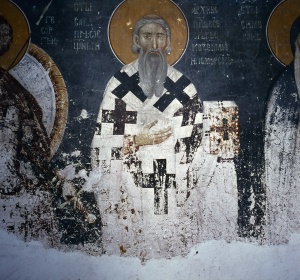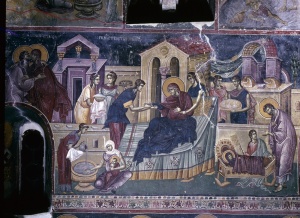Difference between revisions of "Studenica Monastery"
(→Fresco Painting: Additions to fresco painting section) |
m (→Fresco Painting: Minor spelling mistakes) |
||
| Line 19: | Line 19: | ||
The oldest frescoes within the monastery complex can be found in the Church of St. [[Nicholas of Myra|Nicholas]], dating to early 12th century. However, the knowledge about their origin is lacking. | The oldest frescoes within the monastery complex can be found in the Church of St. [[Nicholas of Myra|Nicholas]], dating to early 12th century. However, the knowledge about their origin is lacking. | ||
| − | Initial fresco layer | + | Initial fresco layer in the main church have been finished by 1208 by painters from Constantinople school. Two frescoes from this period thankfully surviving in excellent shape to the modern age best represent the style and the ideas of the initial decoration. Monumental Crucifixion and the fresco Mother of God of Studenica. |
Frescoes in the Kings Church have been painted during 1310's. | Frescoes in the Kings Church have been painted during 1310's. | ||
| Line 25: | Line 25: | ||
Major repainting of the lost or heavily damaged areas have been done in 1569. | Major repainting of the lost or heavily damaged areas have been done in 1569. | ||
| − | For the first time | + | For the first time in the Orthodox iconography all the inscriptions were done in Serbian language, instead of the traditional Greek satisfying both political needs of the Serbian Royal family and practical needs of the population. |
{| | {| | ||
Revision as of 04:46, August 16, 2009
History
Founded in 1186 the Monastery of Studenica, dedicated to the Presentation of the Holy Virgin, is the mother-church of all Serbian temples. The first stage works were completed by the spring of 1196, when its founder Stefan Nemanja (St. Simeon Nemanja) abandoned his throne, becoming a monk. Nemanja's third son St. Sava molds Studenica into the political, cultural and spiritual center of medieval Serbia founding within its walls crucial institutions like the first organized hospital and school[1]. Studenica was continualy expanded by the members of the Nemanjic dynasty. King Radoslav, grandson of the founder added to the church an exonarthex in 1235. King Milutin built a small dedicated to Saints Joachim and Anna in 1314.
There were other church buildings built over time within the monastery complex, but they were either completely lost or remain only as a foundation trace. Church of St. Nicholas, a small single-nave church predating the monastery complex remains there as well.
During Turkish occupation monastery have suffered desecration of conversion to storage building and even the stable. It have also been damaged by fire and earthquake. Smaller restoration efforts happened throughout its history. Major restoration effort occurred in modern times, between 1963-1989.
Monastery of Studenica celebrated its 800th anniversary in 1986.
Architecture
The Virgin's Church is a domed single-nave basilica. At its eastern end there is a three-sided apse, while a narthex faces west. There are also vestibules on the north and the south. In the 1235, a large exonarthex was added, though in much poorer workmanship and stone quality. The main facades were built with slabs of locally queried white marble. Externally, the Church harmoniously reconciles two architectural styles, the Romanesque and the Byzantine. The blending of these two styles eventually produced a particular style of architecture known as the Raska School.
Fresco Painting
The oldest frescoes within the monastery complex can be found in the Church of St. Nicholas, dating to early 12th century. However, the knowledge about their origin is lacking.
Initial fresco layer in the main church have been finished by 1208 by painters from Constantinople school. Two frescoes from this period thankfully surviving in excellent shape to the modern age best represent the style and the ideas of the initial decoration. Monumental Crucifixion and the fresco Mother of God of Studenica.
Frescoes in the Kings Church have been painted during 1310's.
Major repainting of the lost or heavily damaged areas have been done in 1569.
For the first time in the Orthodox iconography all the inscriptions were done in Serbian language, instead of the traditional Greek satisfying both political needs of the Serbian Royal family and practical needs of the population.
See also
- St. Sava of Serbia
References
- ↑ Teodosije, Life of St. Sava, (Belgrade: Danicic Publishing, 1860)




